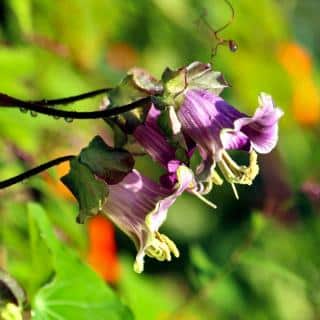

Cup-and-saucer vines are among the most beautiful flowers that decorate our gardens over the summer.
Name – Cobaea scandens
Family – Polemoniaceae
Type – climbing perennial or annual vine
Height – 8 inches to 3 feet (0.2 to 1 m)
Exposure – full sun
Soil – rather rich and well drained
Flowering – April to October
Foliage – deciduous or evergreen, depending on the climate
Thanks to its rapid growth and the ease for which it is cared for, cup-and-saucer vine will enchant you with its incredible ornamental impact.
Sowing is best at the end of winter in a sheltered place, most often from February to April.
Transplanting to the ground usually happens in spring, after the last frost spells.
Cup-and-saucer vines don’t need much care, but these few good practices should help you produce many blooms over a long span of time.
If it freezes in your are and you wish to protect your cup-and-saucer vine from one year to the next, this is what you need to do:
 Native to Mexico, cup-and-saucer vine only needs to be watered in case of dry and hot weather.
Native to Mexico, cup-and-saucer vine only needs to be watered in case of dry and hot weather.
This plant presents abundant and plentiful blooming for the most part of the year.
Its rapid growth, up to 16 to 26 feet (5 to 8 meters) per year, make this plant a great choice to cover old walls, pergolas and other large surfaces.
This is an excellent plant to pair with wrought iron garden ornaments. The sparse leafage highlights the ornament while still fueling blooms!
Many common parasites attack cup-and-saucer vines, such as thrips, aphids and red spider mite or even scale insects.
Be careful during dry spells, especially for pots. Lack of water might interrupt growth of your cup-and-saucer vine.
Credits for images shared to Nature & Garden (all edits by Gaspard Lorthiois):
Flower close-up by Sonja Kalee under Pixabay license
Young cup-and-saucer flowers by Светлана Гурьева under Pixabay license
Columns decorated with cup-and-saucer by chuck b. under © CC BY 2.0